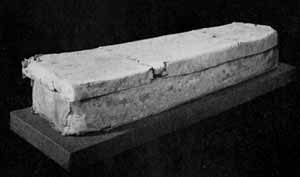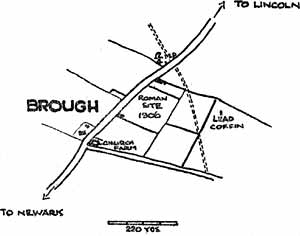Lead coffin found at Crocolana (Brough, Notts.)
A note by ARTHUR SMITH
(Librarian, Curator and Secretary, Gilstrap Public Library, and Municipal Museum, Newark-on-Trent)
THE Discovery. “Believed unexploded bomb in field near church farm, Brough.” This message, given to the county police, led Sergeant Gregory, of Balderton, in whose area the alleged ‘bomb’ was reported, to make investigations which have led to the acquisition of a wedge-shaped lead coffin by the Newark Museum.
The museum committee is indebted to Mr. G. R. Taylor, on whose land the discovery was made, and to Sergeant Gregory, for so promptly notifying the ‘find’ to the curator, for the assistance given in removing the coffin to the museum and for supplying local information—much of which is used in the following report. Had these gentlemen been less active, the story of the discovery might easily have been that of so many other interesting archaeological matters in this district; a story which ends 'Nobody was interested so it was destroyed.’
Sergeant Gregory, when investigating the 'unexploded bomb’ on the 15th May, 1941, removed sufficient earth to discover a lead coffin. Within a very short time the curator was invited to accompany him to the site, and the following day Dr. Ringrose (chairman of the museum committee), Dr. Bowen, principal of the county technical college (a member of the committee) and the curator completed the excavation.

Lead Coffin found at Brough, Notts., 1941.
The coffin was found in the field called ‘Norwell' which is east of the field in which Mr. T. Cecil S. Woolley made some interesting discoveries during 1906. It lay north and south with the foot in the latter direction, resting on the natural soil level only sixteen inches below the surface, 44 yards from the north side of the field and 40 yards from the west side.
In the autumn of 1940 the field was cultivated north and south, by steam plough, one of the shares of which caught the foot of the lid, bending part of it into a position about 60° to the coffin. As the soil settled down during the winter and early spring the bent portion of the lid was disclosed, and in present circumstances its appearance could easily have been mistaken for the fins of a heavy bomb.

Ploughing had been done previously by horse or farm tractor and the crops were wheat in 1940, seeds in 1939, and wheat in 1938, all necessitating comparatively shallow cultivation. Even so, the coffin had been pressed down to a total thickness of only five inches, and two cuts, thirty inches apart, through the lid are evidence of ploughing east and west.
The Coffin. The coffin was made from a single sheet of lead approximately fin. thick, the sides being exactly 6ft. in length, the foot 12in. wide and the head 14in. These measurements give a slight wedge shape to the coffin, the depth of which is 12in. It would thus be necessary to give a slight bulge to the sides in order to receive, easily, the shoulders of an average sized male.
An interesting feature is that all the edges of the sheet of lead have been turned and beaten over to give a thickened edge, one inch wide, on the outside.
The sides and ends were formed by turning them to an upright position, the corners being held together by running hot lead on the inside and outside of the comers.
The Lid. This is more definitely wedge shaped with a width of 18in. at the head and 14in. at the foot, the sides giving a turnover of measurements varying between three and four inches. Unlike the coffin, the corners are simply cut and the side projection turned at right angles over the end. It does not seem possible that the lid fitted well enough for the coffin to be sealed, nor is there any indication that such was the case.
The Contents of the Coffin. Because of the shallow depth of the existing humus on the field the burial, in the first place, was most probably a simple mound, which, through the centuries, had been reduced by wind, rain and plough until it reached the common level of only 16in. above natural soil.
When the lid had been removed, Dr. Ringrose, Dr. Bowen and the curator carefully removed the earth which had washed into the coffin and examined it very carefully by fingering and riddling.
The remains of the skeleton existed in a conglomerate and decomposed mass on the bottom of the coffin and extremely few bones were removed complete; even these crumble to dust if touched with anything but the lightest pressure. When attempting gently to scrape away with a pocket knife the wet soil from the bones with the idea of exposing them in the coffin, pieces came away with the soft earth.
It has been possible, however, to obtain some idea of the length of the femur and the size of the foot.
The teeth are in perfect condition, especially the large molars which show no sign of decay. The left central and lateral incisors show considerable wear through the enamel and the upper central incisor has worn two very clear facets on the front of the lower tooth. It is significant that no teeth were found belonging either to the right upper or lower jaw nor was there any part of the right side of the jaw-bones to be found. To those with imagination these details suggest that the skeleton is that of a man of between 45 and 50 years of age whose height was approximately 5ft. 8in. and who met his death through an accident.
No sign of personal adornment was found in the coffin nor were there any pieces of corroded metal which might have proved useful in attempting to place a period to the burial. No incised or impressed lettering or ornament appears either inside or outside the coffin.
Three fragments of pottery were found near the head, and the rim fragment is of coarse grey ware usually associated with cinerary urns. The size of the pot would be almost 8in. in diameter and nearly 12in. high. Had there been more of it the discovery within the coffin would have provided some interesting speculation. The late second or early third century is the period given to the rim fragment but this alone cannot provide a period to the burial.
There was nothing to suggest that the coffin had been cased in wood nor was anything found in close proximity to it.
So far as can be ascertained, this is the only plain coffin of its kind which has been found in the county of Nottingham.
Now that the site is known it is hoped that at some future date further examination of the ground will provide useful data. Such activity cannot take place during the present intensive agricultural campaign but its desirability will not be lost sight of by the Newark Museum Committee.
